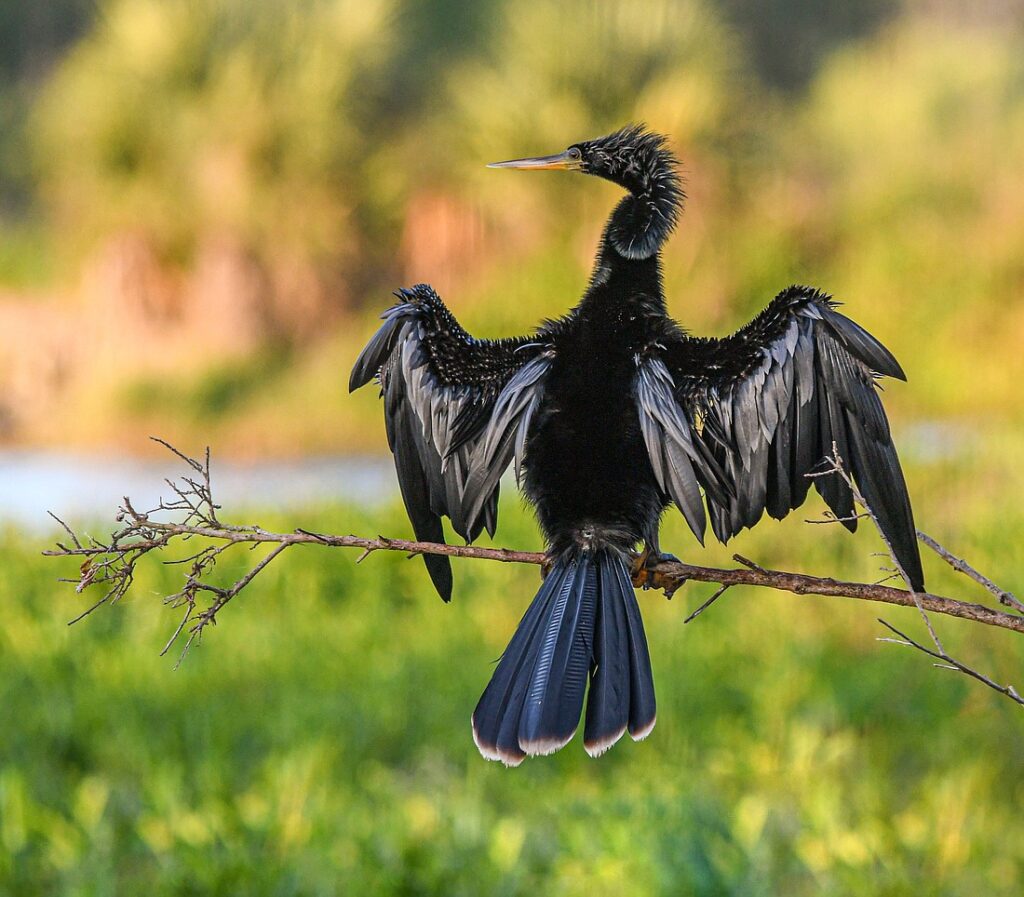I like to alternate my posts between scientific and philosophical musings with looks at some interesting birds. Today the bird is the Anhinga.
The word “anhinga” is derived from the native Brazilian Tupi-Guarani language word “ana’ĩnĩa,” which translates to “devil bird”, “snake bird” or “evil spirit of the woods.” The Tupi people (one of the largest indigenous groups of people in Brazil) named the bird because of its eerie appearance and hunting behavior. Europeans adopted this name which evolved into “anhinga,” the common English name for the species. The scientific name is Anhinga anhinga. {A number of animal species have the same name for both genus and species, which creates a scientific name known as a tautonym.)

Anhingas do not have oil glands to waterproof their feathers as most water birds do and the microscopic structures of their feathers allow the water to penetrate through the feathers to the skin. This makes them effective swimmers, not having to fight a buoyant body. When they swim, most of their body is underwater with only the head and neck exposed, resembling a swimming snake. After hunting, Anhingas sit in shrubs and trees with their back to the sun and stretch out their waterlogged wings to dry. Their plumage is primarily dark brown or black with silver-white streaks and spots on the back and wings; the bill is yellow, and the toes are webbed. They rarely walk on land but are excellent fliers. The pointed bill and long tail contrast with the similar aquatic- dwelling cormorant which has a hooked beak and short tail.
The Anhinga inhabits a variety of wetlands, especially those sheltered by trees and primarily feeds on small fish, but it may also consume amphibians, crustaceans, leeches, and even small reptiles. It hunts by swimming stealthily through the water, using its long neck to spear fish. Rather than chase a prey item they wait for it to come close enough to attack. The neck, especially adapted to curl back into an S-shape, enables the bird to lunge forward with great force. The bird is sometimes called a “darter” because of this action. Once the prey is impaled on its bill, the Anhinga brings it to the surface to swallow it whole.
Breeding season for Anhingas begins with the males engaging in elaborate courtship displays to attract females. The displays often involve exaggerated movements of their long necks, opening and closing their bills, and spreading their wings to showcase their striking plumage. Once a pair has formed, they build a nest together in a colony, typically in trees near water bodies such as swamps, marshes, or lakes, high above the ground. The female lays two to five pale blue eggs. Both parents share incubation duties for about four weeks. The hatchlings are altricial, meaning they are born naked and relatively undeveloped, requiring considerable care. The chicks grow rapidly on a diet of fish the parents bring them. After about seven to eight weeks, the chicks become fully feathered and are ready to fledge. At this stage, they leave the nest and begin practicing their flying and hunting skills. The parents continue to support and feed them during this transitional period until they can fend for themselves.
There are four species of Anhinga in the family Anhigidae, one each in Northand and South America, Africa, Asia, and Australia.
An anhinga in flight reminds us of a javelin flying through the sky.
Interesting article thanks Roger. Given that lack of oil glands is an advantage for swimming, what is the disadvantage to the Anhinga?
They have to spend time drying themselves and warming up.
Sir, excellent writing and lots of information. It may be a coincidence that now a days Oriental Darter is there at Sukhna Lake Chandigarh where we live and daily we take number of pictures of Snake Bird doing fishing. I also write blog and was thinking about my next blog with updated pictures of Snakebird. Anyway your blog is very informative.
Thanks for sharing such blogs.
What are some key characteristics of the Anhinga’s breeding behavior, including courtship displays, nesting habits, and parental care? Regards, Telkom University/a>